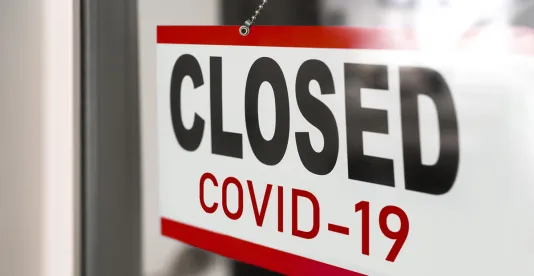On August 6, 2020, in Rose’s 1 LLC, et al. v. Erie Insurance Exchange, Civ. Case No. 2020 CA 002424 B, a District of Columbia trial court found in favor of an insurer on cross motions for summary judgment on the issue of whether COVID-19 closure orders constitute a “direct physical loss” under a commercial property policy.
At its core, the decision ignores key arguments raised in the summary judgment briefing and is narrowly premised on certain dictionary definitions of the terms, “direct,” “physical,” and “loss.” Relying almost entirely on those definitions – each supplied by the insureds in their opening brief – the court set the stage for its ultimate conclusion by finding “direct” to mean “without intervening persons, conditions, or agencies; immediate”; and “physical” to mean “of or pertaining to matter ….” The court then apparently accepted the policy’s circular definition of “loss” as meaning “direct and accidental loss of or damage to covered property.” Importantly, however, despite recognizing the fundamental rule of insurance policy construction that the court “must interpret the contract ‘as a whole, giving reasonable, lawful, and effective meaning to all its terms, and ascertaining the meaning in light of all the circumstances surrounding the parties at the time the contract was made,’” the court apparently ignored the insureds’ argument that the term “property damage” is specifically defined in the policy to include “loss of use” without any specific reference to physical or tangible damage.
Based on their supplied definitions and those from the policy, the insureds asserted that the “direct physical loss” sustained was the loss of use of their restaurant properties. The insureds argued that the loss was “direct” because the closures were the direct result of the mayor’s orders without intervening action. The insureds further asserted that the loss was “physical” because “the COVID-19 virus is ‘material’ and ‘tangible,’ and because the harm they experienced was caused by the mayor’s orders rather than ‘some abstract mental phenomenon such as irrational fear causing diners to refrain from eating out.’” As would prove critical, however, the insureds did not argue that COVID-19 was actually present on the insured properties at the time when the properties were forced to close, nor did the insureds argue that the pandemic nature of COVID-19 necessarily means that COVID-19 is present globally. Finally, the insureds argued that the term “loss” includes loss of use, and the insureds were deprived of the use of their properties.
The court rejected each of the insureds’ supplied definitions as a basis to trigger coverage under the facts alleged. The court concluded that, standing alone and absent intervening actions by individuals and business, the orders did not effect any direct changes to the properties. The court next concluded that, because no evidence was offered that COVID-19 actually was present on the insured properties or that the orders had any effect on the material or tangible structure of the insured properties, the effect of the orders was not “physical.” Finally, the court concluded that the terms “direct” and “physical” modify the term “loss” in the phrase “direct physical loss” and that, therefore, the loss of use of the restaurants would need to have been caused, without intervention of other persons or conditions, by something pertaining to matter – “in other words, a direct physical intrusion on to the insured property.”
In short, the Roses 1, LLC decision holds that, under the very narrow facts and definitions presented in that case, municipal orders closing restaurants in connection with COVID-19 did not, without more, constitute a “direct physical loss” under the policies at issue in that case. But the decision is not without significant and unique limitations.
First, the court adopted particular dictionary definitions of “direct” and “physical” that were proposed by the insureds but which are not uniformly accepted definitions of those terms. For example, in other cases, “direct” has been defined to mean the proximate cause.
Second, as noted, the court apparently ignored the policy’s own definition of “property damage,” and in doing so, ignored the fundamental rule that the policy and not just the particular coverage part must be read as a whole.
Third, and critically, the insureds offered no evidence that COVID-19 was present in their restaurants. Medical science has found that COVID-19 has a direct, physical impact on property and that the communicable disease remains on property rendering that property hazardous and unusable long after it is deposited by an infected person. Likewise, medical science is increasingly of the opinion that COVID-19 directly affects indoor air and renders premises uninhabitable for extended durations due to the airborne transmissibility of the disease. The insureds in Rose 1, LLC apparently failed to allege or present evidence of these significant facts. Indeed, direct and/or circumstantial evidence of the presence of COVID-19 in other instances might yield a different result as to whether loss of use constitutes “direct physical loss.” And, while the court distinguished cases in which some physical alteration to property rendered the property substantially or completely unfit for use, the court’s discussion leaves open the possibility that the presence of COVID-19 on a property may result in covered loss of use.
Fourth, the court cited, but failed to substantively address, the case in which the threat of a landslide constituted direct physical damage to homes by virtue of rendering them uninhabitable, Murray v. State Farm Fire & Casualty Co., 509 S.E.2d 1, 16-17 (W. Va. 1998). In fact, no court to consider this issue to date appears to have provided any careful analysis of the circumstance that the threat of COVID-19 becoming present at a premises may, on its own, constitute direct physical damage, much as the threat of a landslide, because it renders the property unfit for use. In other words, with a widespread pandemic like COVID-19, a property owner cannot open its doors without substantial risk of workers and patrons bringing COVID-19 onto the premises, especially at present, when record-breaking numbers of COVID-19 cases are reported daily. The court in Rose’s 1 LLC did not fully address such circumstances.
In sum, while the decision in Rose’s 1 LLC appears facially to favor insurers and is certain to be trumpeted as a victory for the insurance industry, the decision addresses only a narrow circumstance and fails to fully address the myriad issues raised by the more than one thousand cases seeking business interruption coverage for COVID-19 losses.
This article features contributions from Michael L. Huggins.




 />i
/>i

